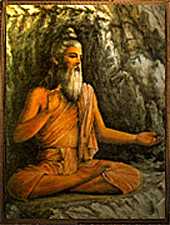
Unity in Diversity
the
view from the Upanishads
This article, by Rob Tillett, astrologer, wizard and founder of Astrology on the Web, takes a deep look at the underlying Unity expressed in the Diversity of our world, as articulated in the teachings of the Upanishads, the sacred scriptures of India. There are four great classes of Hindu Scripture: Agama, Purana, Smrti and Veda. Upanishad was Jnana-kanda (understanding of the spiritual knowledge in the Vedas), given by the Guru (illumined teacher) to the students of the inner circle. Upanishad means the inner or mystic teaching. Although this article is not strictly astrological, it does address the issue of the underlying unity and spiritual connection that is one of the ways that astrology can be seen to have a deep basis in nature.
In ancient India, the Upanishads were esoteric commentaries or expansions on the scriptural teachings of the Vedas, expounded by the gurus to their followers, but not until recently given out to uninitiated members of the general public. The ancient Sanskrit word Upanishad is also derived from the idea of "sitting down near" the guru to receive his teaching in the peaceful environment of the forest ashram, or hermitage. The Upanishads, however, have now been published and most of them are available in translation.
|
|
Indian thought from the earliest times has been much concerned with reconciling a mystical sense of the one fundamental reality with an evident, manifold expression of the diversity and plurality of forms. The profound insights recorded in the earliest Upanishads have tended to generate an all-embracing monism (underlying unity of all things) that has largely permeated the body of Indian philosophy—particularly in the school of Vedanta, which has been the most influential of the six traditional divisions of orthodox philosophy on the subcontinent.
The opposing view to monism (advaita) is dualism (dvaita). Dualism holds that there is a separation and fundamental difference in essence between spirit and matter, or between matter and mind. This view is more common in the West, due to the influence of the Church and of Rene Descartes , but in India, both dualism and monism have their adherents. However, even the dualistic systems, including the Yoga, the Sankhya and the Dvaita Vedanta, may be resolved at their deepest levels into a form of qualified monism. These schools also find support in the Upanishads, notably in parts of the Svetasvatara. (see Svet. 1: ix)
Esoteric doctrines of the Indian systems, however, while recognising an apparent diversity as a form of reality, hold that all parts of the perceptual world are profoundly interconnected: coalescing within their essential structures into one fundamentally indivisible reality, the universal wave of consciousness. This deep truth and the search for useful methods of its realisation have been both goal and focus of the Indian spirit since prehistoric times.
The Brahman, the deep essence of all beings
The essential difference between the dominant Western world-view and the traditional Upanishadic world-view lies in this perception of a deep, underlying unity beneath the apparent world of diversity. The world that manifests to our senses is thought either to be Maya, an illusory veil covering the radiant truth, or at least a thoroughly deceptive combination of the three modes of Prakriti, material existence. The three modes are called gunas. They are sattva, rajas and tamas—clarity and purity; activity and passion; darkness and inertia. Their interaction is thought to generate everything in the material universe, up to and including the mind and emotions, for these states are considered to consist in subtle varieties of natural substance. The three gunas make an interesting comparison with the three quarks, the fundamental building blocks of matter in modern sub-atomic physics.
This comprehensive oneness is thought to be both conscious and purposive, pervading and underpinning the appearance of the material world and the structural elements of the more subtle levels of being. Yet, paradoxically, it is believed to be at the same time beyond consciousness and intention, beyond all qualities, containing within its nature both being (sat) and non-being (asat): existence and non-existence. This all-embracing reality is called the Brahman: the highest and deepest, innermost nature of all.
Article Source - http://www.astrologycom.com
https://ajiio.in/woslXgV
https://ajiio.in/woslXgV
